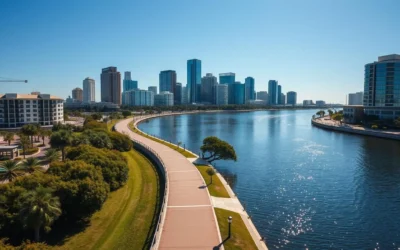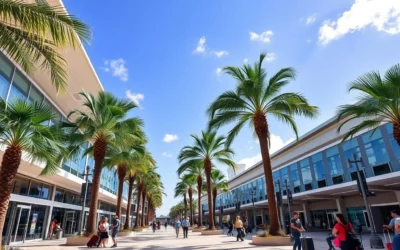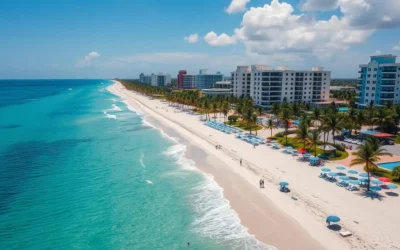When you visit Florida, you’ll encounter a rich tapestry of languages that reflect the state’s diverse cultural heritage and immigrant communities.
Florida stands out as one of America’s most linguistically diverse states, with over 100 languages spoken throughout its neighborhoods.
While English serves as the official language, approximately 29.4% of residents speak languages other than English at home. The language diversity in Florida has been shaped by centuries of immigration and its strategic location as a gateway between the United States and Latin America.
Understanding the language diversity in Florida will enhance your travel experience, whether you’re visiting for tourism, business, or considering relocation to the Sunshine State.
The Linguistic Landscape of Florida
As you explore Florida, you’ll discover a melting pot of languages that enhance the travel experience. The state’s linguistic diversity is a reflection of its cultural richness, with many languages contributing to its unique character.
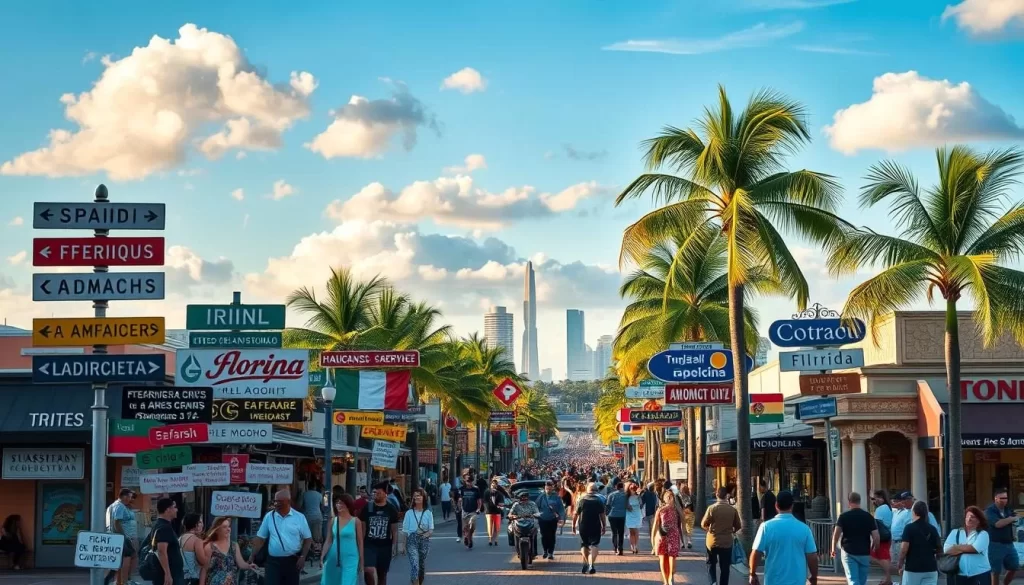
A Melting Pot of Languages
Florida’s language diversity is particularly noticeable in communities where Spanish and English coexist, creating a rich cultural exchange. In addition to these two languages, you’ll find Haitian Creole, Portuguese, and various Asian languages, each contributing to the state’s cultural tapestry.
The coexistence of multiple languages has created vibrant, multicultural communities with unique cultural offerings.
| Language | Prevalence | Cultural Impact |
|---|---|---|
| Spanish | High | Significant influence on cuisine, festivals, and cultural events |
| Haitian Creole | Moderate | Contributes to the cultural diversity in areas with Haitian communities |
| Portuguese | Moderate | Enhances cultural exchange through language and cultural events |
Why Language Diversity Matters for Visitors
Understanding Florida’s language diversity can enhance your travel experience by allowing you to connect more deeply with local communities and cultures. Many tourist destinations offer services and information in multiple languages to accommodate visitors.
- Language diversity creates unique cultural experiences through food, festivals, music, and art.
- Learning a few basic phrases in languages like Spanish or Haitian Creole can enhance your interactions with locals.
- Many businesses in tourist areas employ multilingual staff to ensure effective communication with international visitors.
By embracing the language diversity, you can enjoy a more immersive and engaging experience in Florida.
Historical Evolution of Languages in Florida
As you explore Florida, you’ll discover a linguistic landscape shaped by centuries of change. The state’s language profile is a reflection of its diverse cultural heritage and the various populations that have settled there over time.
Pre-Colonial Indigenous Languages
Before European colonization, Florida was home to numerous indigenous languages. Native American tribes such as the Timucua and Calusa had their own distinct languages, contributing to the state’s linguistic diversity. These languages played a significant role in shaping the region’s cultural identity.
Colonial Language Shifts: Spanish to English
The arrival of Spanish and later English colonizers brought significant changes to Florida’s linguistic landscape. Spanish became the dominant language during the colonial period, leaving a lasting legacy in the state’s language profile. As English took hold, particularly after Florida became a U.S. territory, it gradually became the official language.
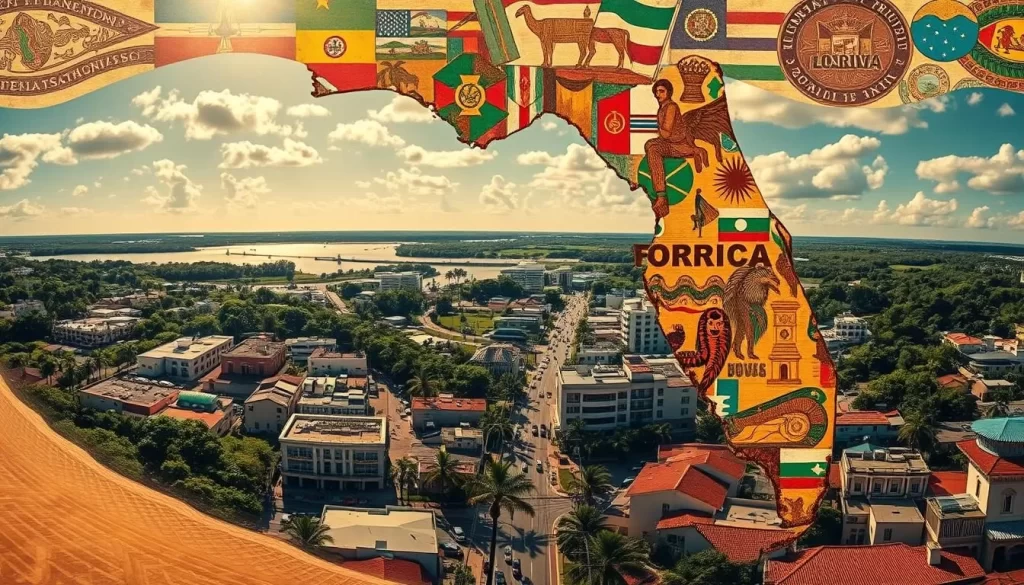
Immigration Waves and Their Linguistic Impact
Successive waves of immigration have reshaped Florida’s linguistic diversity. The influx of Cubans, particularly after the Cuban Revolution, significantly strengthened Spanish usage in the state. Additionally, immigrants from Haiti, Brazil, and other countries have introduced new languages, such as Haitian Creole and Portuguese, enriching the state’s linguistic tapestry. Today, you can experience the lasting impact of these immigration patterns in the region’s bilingual character and diverse language communities.
English: Florida’s Official Language
As the official language of Florida, English plays a crucial role in the state’s daily life. It is the primary language used in government, education, and business.
The Path to Official Status
English became Florida’s official language through legislative processes that recognized its dominance in state affairs. This status was granted to facilitate communication and governance across the state’s diverse population.
English Usage Statistics Today
Today, approximately 60.2% of Florida’s population speaks only English at home or speaks English “very well.” The percentage of English speakers varies significantly across different regions.
- Nearly 75% of the total population in metropolitan areas like Orlando speak English.
- Some counties report over 90% English speakers, while others have much lower percentages.
- Despite being the official language, about 11.7% of Florida residents have limited English proficiency.

| Region | English Speakers Percentage |
|---|---|
| Orlando | 75% |
| Miami-Dade County | 27.2% |
| Other Counties | Over 90% |
To speak English proficiently is beneficial for both residents and visitors, especially in tourism and business contexts. As of today, English remains the dominant language in Florida, with a stable percentage of speakers across the state.
Spanish: The Second Most Widely Spoken Language
As you explore the linguistic landscape of Florida, you’ll discover that Spanish is the second most widely spoken language. Florida boasts a thriving community of Spanish-speaking residents, with roughly 17% of the total population speaking Spanish. This demographic is particularly significant in cities like Orlando, where the ability to speak Spanish can open many roads to communication.
Cuban and Latin American Influence
The influence of Cuban and Latin American immigrants has shaped the Spanish-speaking community in Florida. The first surge of Latin American immigrants occurred in the 1890s, with Cuban and Puerto Rican immigrants fleeing Spanish colonization. Today, this influence remains strong, with many communities maintaining their cultural heritage. The Cuban community in Miami, for instance, is known for its vibrant culture.
Spanish-Speaking Communities Across Florida
Spanish-speaking communities are distributed throughout Florida, with varying concentrations and origins. In Miami-Dade County, approximately 64% of residents speak Spanish at home. You can find distinct Spanish-speaking communities across different regions: Cuban influence is dominant in Miami, while Puerto Rican communities are prominent in Orlando.
| City | Spanish-Speaking Population | Notable Community |
|---|---|---|
| Miami | High | Little Havana |
| Orlando | 17% | Puerto Rican |
| Tampa | Significant | Ybor City |
Florida, United States: Official and widely spoken languages beyond English and Spanish
The Sunshine State boasts a rich tapestry of languages, extending far beyond English and Spanish. As you explore Florida, you’ll discover a diverse population that speaks a multitude of languages from around the world.
Haitian Creole
Haitian Creole is one of the notable languages spoken in Florida, particularly in areas with large Haitian communities. You can find Haitian Creole speakers in cities like Miami and Fort Lauderdale.
Portuguese
Portuguese is another significant language in Florida, with many speakers found in the state’s metropolitan areas. The presence of Portuguese reflects the historical and cultural ties between Florida and Portugal.
French and French Creole
French and French Creole are also among the top languages spoken in Florida. You can hear these languages in certain communities, particularly those with historical ties to France and the French Caribbean.
Other Significant Languages
Other languages that are widely spoken in Florida include Chinese (including Cantonese and Mandarin), Vietnamese, Tagalog, Arabic, German, and Russian. These languages represent the diverse cultural heritage of the population in the states. You can experience the vibrant cultural diversity firsthand by visiting the various ethnic communities throughout Florida.

The Business of Languages in Florida
Florida’s diverse linguistic landscape has given rise to a thriving industry that caters to the needs of its multilingual population. This industry supports various sectors, including tourism, international trade, healthcare, and the legal system.
Multilingualism in Tourism and Hospitality
The tourism industry in Florida benefits significantly from multilingual services. With millions of tourists visiting the state each year, the ability to communicate in multiple languages enhances the visitor experience and drives business for hotels, restaurants, and attractions.
International Trade and Commerce
Florida’s strategic location and diverse economy make it a hub for international trade. Companies engaged in international commerce require translation and localization services to effectively communicate with partners and customers.
Translation and Interpretation Services
The demand for translation and interpretation services in Florida is high, driven by the need for accurate communication in healthcare, law, and business. Certified translation services ensure that documents are translated accurately, while interpretation services facilitate real-time communication.
As the industry continues to grow, the importance of healthcare translation and localization services becomes more apparent. Ensuring that all individuals have access to essential services, regardless of their language proficiency, is crucial.
Conclusion
The Sunshine State is home to a vibrant tapestry of languages, reflecting its cultural diversity and international ties. As you’ve explored, Florida’s linguistic landscape is characterized by English as the official language, with Spanish being widely spoken across the state. The diverse population contributes to the richness of languages Florida has to offer, including top languages like Haitian Creole and Portuguese.
This diversity necessitates translation services and fosters cultural exchange. Understanding this linguistic heritage enhances your experience, whether you’re visiting or living in Florida. The state‘s multilingual character is a unique aspect of its identity, making it an exciting place to explore.
The above is subject to change.
Check back often to TRAVEL.COM for the latest travel tips and deals.

